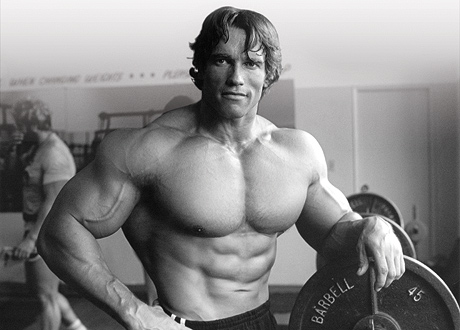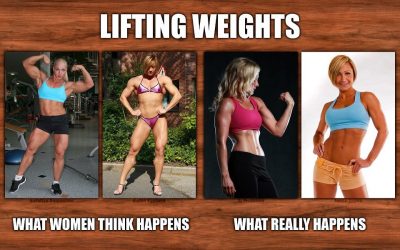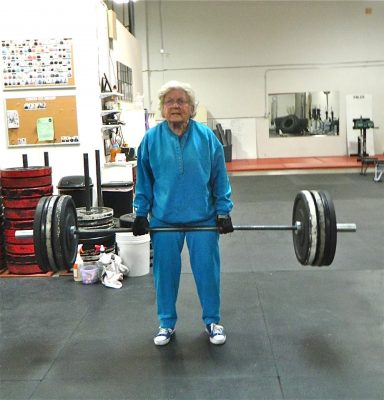Most women are afraid to lift weights like men because they think they will look bulky and like the women we see on the left hand pictures. It is time to demystify this idea and explain why this is impossible (provided than no hormones and/or anabolic steroids are used), and why strength training is key and a great ally to improve a number of parameters, including body composition.
Overuse of low-intensity training protocols by women is too common. Too much emphasis is placed on cardio, machine use, treadmills, bicycles, light loads, and too little emphasis is put on what will promote better physiological adaptations for increasing women’s functional capacity – strength training. If you want to bring more years into your life, you should start looking at strength training as one of the most effective anti-aging tools on Earth. There is no system in our body that is not influenced by strength training! Have I told you that it is cheaper than the creams you rub on your body every day?
I will divide this article into three parts. First, let’s highlight the myths of strength training for women, which were already addressed by Ebben & Jensen in 1998 in Strengthening for women: debunking myths that block opportunity. Second, let’s highlight its main benefits, and third, let’s explain why you will not look like Arnold Schwarzenegger.
1. MYTHS OF STRENGTH TRAINING FOR WOMEN
- Strength training will cause women to become big and heavy.The truth is that strength training helps to reduce body fat and increase lean mass. These changes may result in a slight increase in weight since the lean mass is more dense than fat (note: if this disturbs you throw the scale away and look more at yourself in the mirror!). Strength training will result in increased strength, no change or a decrease in the hip and waist perimeters and a slight increase in the perimeter of the upper body. Only women who are genetically predisposed for hypertrophy and who participate in high volume and intensity workouts may see substantial increases in the circumference of their limbs.
- Women should use different training methods than men.Women are often encouraged to use machines and to do many repetitions slowly because they are afraid that the use of free weights, manual resistance, explosive movements or exercises that use their body weight as resistance will cause injury. In fact, there is no evidence suggesting that women are more likely than men to injure themselves during strength training. The most important factors to reduce the risk of injury are based on exercise technique and training individualization.
- Women should avoid high intensity training or training with high loads.Women are usually encouraged to use smaller weights in their strength training (i.e., light dumbbells) but the problem is that these light loads are substantially below what is required to promote physiological adaptations. Women need to train at intensities high enough to promote adaptations in bones, muscles, cartilage, ligaments and tendons. When the intensity of the exercise is low, that is, when the stimulus is insufficient, the physiological benefits are minimal. To maximize the benefits of strength training, women should train close to their maximum. For women who have had children, imagine that this is what you have to “push” to get the greatest benefits.In short, there is no reason for women to train differently from men with regard to training intensity. If you intend to get different results, you need to leave aerobic classes and pink weights to start lifting real weights.
2. STRENGTH TRAINING BENEFITS FOR WOMEN
In addition to improving body composition (loss of fat mass and increase in lean body mass), strength training will help you:
- Increase bone remodeling. You will get stronger bones and reduce the risk of osteoporosis (LINK, LINK, LINK). Keep in mind that stronger bones can also result in total weight gain, but this is good, strong bones are a sign of health;
- Strengthen the connective tissue. You will increase your joint stability and reduce the risk of injury (LINK). As in the previous point, same thing can happen regarding weight gain;
- Increase functional strength for activities you enjoy or for your daily activities (e.g. playing with your kids, carrying grocery shopping, climbing stairs).
- Increase self-esteem and confidence. A stronger body will make your mind stronger and unstoppable!
- Fight the effects of metabolic syndrome and other common chronic diseases in our society, such as cardiovascular disease, type II diabetes, cancer, fibromyalgia, rheumatoid arthritis and Alzheimer’s disease (LINK, LINK).
- Increase longevity in a healthy way. Strength training will potentiate the release of anabolic hormones that play an important role in tissue regeneration and anti- aging (LINK).
In summary, strength training has the potential to restore the shape of your glutes, the glow of your skin and the tonus of those parts of the body that you think is only possible through surgery, miracle supplements and advanced techniques of “muscle toning”. Strength training can also help you live the life of your dreams.
3. WHY I WILL NOT BECOME ARNOLD SCHWARZENEGGER?

Women have different physiological characteristics from men and this is the reason why women have greater difficulty in gaining muscle than men. As I said at the beginning of this article, if there are no hormones and/or anabolic steroids involved, it is very unlikely that women will look like men.
- Diferences in muscle fibersAlthough women have the same types of muscle fibers that men have (fast-twitch fibers and slow-twitch fibers), the amount of muscle fibers they have and their size is smaller. Remember that slow-twitch fibers (type I) are used primarily in endurance efforts whereas fast-twitch fibers (type II) are used primarily in rapid and explosive movements. In women, because they have 70-75% type I fibers, it becomes even more difficult to move loads at high speeds. This means that the potential for increasing the cross-sectional area of the muscle (i.e. muscle size) and for increasing the rate of force development is lower in females than in males.
- Diferences in strength and powerThe average total body strength of a woman corresponds to about 60% of the average total body strength of a man. In average, upper body strength in women ranges from 25-55% of men’s upper body strength. Regarding lower body strength, it seems that women are stronger in relative terms. In average their capacity is 70-75% of what is observed in men. It is therefore not surprising that most women find it more difficult to lift weights with arms and upper body (e.g. push-ups and pull-ups) than with legs and lower body (e.g. squats and lunges).
- Diferences in hormone levelsThe most obvious difference in the mechanisms that determine the adaptations to training of men and women is the sex hormone, testosterone. Both men and women produce testosterone, the difference is that testosterone concentrations in men are 10 to 20 times higher than in women! It appears that women are more dependent on pituitary secretion from growth hormone and other growth factors to help mediate changes in muscle, bone and connective tissue. In fact, although strength training adaptations do not occur in the same way, it has been reported that women have higher bioavailable concentrations of growth hormone at rest than men. Fortunately, strength training and metabolic resistance training can also increase growth hormone levels.Also, if you begin to lift weights in a progressive manner, you will continue to maintain your femininity, you will not grow a mustache, beard or hair in your chest. You will not get bigger or full of muscles. On the contrary, you will get leaner, stronger, younger, smarter and much more attractive to the opposite sex. But do not be fooled, to get the greatest benefits in training, you need to work hard and realize that it takes serious effort to induce the metabolic adaptations you seek (e.g. improving body composition and biological aging). This does not happen overnight. You will need time, consistency and discipline. There are no miracle pills.
In conclusion, before beginning a strength training program, be aware that you must have movement competency in the first place. Just as you would not begin to calculate derivatives in mathematics before you know how to add and subtract, it also makes no sense to start lifting heavy loads if you have restrictions and/or asymmetries in your movement profile. The quality of movement is the foundational support for functional strength development so this “ingredient” will always have to come first.
For a graphic resource check out this nice infographic from Positive Health Wellness.
See you soon and enjoy 🙂
Pedro Correia
References
Ciccolo Joseph T, Carr Lucas J, Krupel Katie L, Longval Jaime L. The Role of Resistance Training in the Prevention and Treatment of Chronic Disease. American Journal of Lifestyle Medicine July/August 2010 vol. 4 no. 4 293-308.
Cussler EC, Lohman TG, Going SB, Houtkooper LB, Metcalfe LL, Flint-Wagner HG, Harris RB, Teixeira PJ. Weight lifted in strength training predicts bone change in postmenopausal women. Med Sci Sports Exerc. 2003 Jan;35(1):10-7.
Ebben WP, Jensen RL. Strength training for women: debunking myths that block opportunity. Phys Sportsmed. 1998 May;26(5):86-97. doi: 10.3810/psm.1998.05.1020.
Hurley BF, Hanson ED, Sheaff AK. Strength training as a countermeasure to aging muscle and chronic disease. Sports Med. 2011 Apr 1;41(4):289-306. doi: 10.2165/11585920-000000000-00000.
Kraemer WJ, Ratamess NA. Hormonal responses and adaptations to resistance exercise and training. Sports Med. 2005;35(4):339-61.
Nickols-Richardson SM, Miller LE, Wootten DF, Ramp WK, Herbert WG. Concentric and eccentric isokinetic resistance training similarly increases muscular strength, fat-free soft tissue mass, and specific bone mineral measurements in young women. Osteoporos Int. 2007 Jun;18(6):789-96. Epub 2007 Jan 31.
Stone MH. Implications for connective tissue and bone alterations resulting from resistance exercise training. PubMed PMID: 3057317.
Winters KM, Snow CM. Detraining reverses positive effects of exercise on the musculoskeletal system in premenopausal women. J Bone Miner Res. 2000 Dec; 15(12):2495-503.
Zatsiorsky V., Kraemer, W. Science and Practice of Strength Training 2nd Edition. Human Kinetics (2006).
If your grandfather is a normal person, it is very likely that he has been to the doctor many times, that he is on medication, that he does not hear very well and that he does not have the same locomotion capacity and reasoning that he had some years ago.
Doctors say this is “normal” and typical of the advancing age. They also prescribe drugs based on the belief that this will improve the quality of life of these people. I do not say that this is not necessary in some cases, but I do not believe that this is the best approach to increase health span. Although they “breathe” I think that they deserve better and more.
More than two years ago, a piece in a portuguese newspaper stated that the Portuguese lived longer and longer but less healthy. The piece also mentioned: “Portuguese women have one of the longest life expectancy in the world, but, paradoxically, enjoy far fewer healthy years than women from the best-ranked countries in Europe.”
When reading the piece, the first thing I thought was: we have to be really stupid, because even with the daily advances of medicine and scientific knowledge, we have not yet been able to understand what are the causes behind this SICK LONGEVITY. The problem is not the advancing years, the problem lies in nutrition and exercise related advice we hear every day (especially in hospitals), which is simply erroneous. If prevention campaigns and the information leaflets in hospitals were really supported by scientific evidence, one would not witness so many people suffering from chronic pain, diabetes, heart disease, osteoporosis, sarcopenia, autoimmune diseases and cancer.
Everyone recognizes that physical exercise is key to optimal body function (our brain and body did not develop while sitting on our asses), and that, unlike drugs, has a positive and self-regulating impact on the various systems of the human body.
Exercising is more effective on improving your health than any patented medicine.
“But I walk an hour every day”
Let me tell you one thing, walking is the least you can do to keep your body working. If you tell me that is either walking or lying back on the couch eating ice cream, then you better walk. But if you tell me that you want to live a healthy life until you die, maintain your autonomy, decrease the risk of falls, increase self-confidence, sleep better, recover faster from an injury and not be part of the statistics we saw above, then I recommend you start seriously thinking about lifting weights and engaging in strength training. Walking will not give you, even by shadows, the same benefits as strength training.
Another thing, if you are one of those people with cardiovascular disease, your doctor (or some Dr. from Google) has probably told you that walking is important to improve your cardiovascular health. The problem is that walking will not help you much. The lack of aerobic capacity is not a risk factor for heart disease, a sedentary lifestyle is! This means that you may have a huge aerobic capacity and a heart disease at the same time. In fact, according to this study published in the 2006 American Heart Association Journal (LINK), to this one published in 2008 in the European Heart Journal (LINK) and to this one published in the Mayo Clinic Proceedings (LINK) in 2012, marathoners are those who appear to be at increased risk of developing cardiovascular disease.
Furthermore, according to the cardiologist Henry A. Solomon in the book “The Exercise Myth”, cardiovascular health refers to the absence of heart and blood vessel disease, and not to an individual’s ability to do a certain amount of physical work. According to Dr. Solomon, your cardiac health is determined by the condition of various structures of the heart, including the heart muscle, the valves, the special cardiac tissues that carry electrical impulses and the coronary arteries. So, do not expect exercise to “clean” what you practice in your daily diet.
The cardio craze came about in the late 60’s / early 70’s through Dr. Kenneth Cooper, the person who designed the Cooper test for US military use. It was roughly from this moment on that VO2max (a measure of aerobic capacity) was “elected” the holy grail of physical fitness. Although relevant for performance and longevity, VO2max is not the only marker of physical fitness. Strength in its various forms has been more strongly correlated with increased longevity than VO2max. While strength training can increase both functional strength and aerobic capacity, the typical cardio training will not make you stronger and will only slightly “at best” increase your VO2max.
Why Strength Training?
Because you tend to lose strength and power as you age, and because several studies have shown that loss of strength and muscle mass are associated with increased mortality (LINK, LINK, LINK). Fortunately, lifting weights is the best stimulus to counteract this trend and to increase our functional capacity. Under normal conditions, strength peaks between the ages of 20 and 30, remaining relatively stable or decreasing slightly over the following 20 years. But this is dependent, of course, of what one does in training.
It is in the sixth decade of life that decreases in strength are quite pronounced. According to several longitudinal studies, declines in muscle strength are around 15% between 60-70 years of age and 30% after age 70. Most reasons relate to the loss of muscle mass, pronounced loss of fast-twitch muscle fibers, decreased endocrine function, loss of tissue mobility / elasticity and cell dehydration. All of these can be minimized by following a proper strength training program.
Yes, it is possible to start strength training at any age, I know people who started training at 50, 60 and over 80, it’s all a matter of mindset and willpower. Also, you need to train according to your needs as opposed to the convenience of most gyms (i.e. spending hours on the treadmill / elliptical / bike, going through all the machines and ignore training with free weights) where supervision, tutoring and skill learning are dismissed.
Does this mean that I should get my grandparents to lift Olympic bars and weights without any criteria? Of course not, that would not be very smart. To get the most benefit of lifting weights you have to walk a path and create a solid movement base. You have to be screened and assessed for movement quality and physical parameters. Preferably guided by a fitness professional or personal trainer knowledgeable in movement and strength training science.
Listen, your doctor’s opinion might be highly valuable, however remember the following: 1) your doctor is not a specialist in movement (which is ok, they can not be trained in everything); 2) your doctor has no experience training people (which is also ok, it’s not their job); 3) your doctor probably does not even know how to lift weights or to move well (this is obviously not ok!). In other words, just as you would not ask advice on surgery techniques from strength coaches, you should also not ask advice on training methodologies and forms of physical exercise from surgeons.
Oh, and before you tell me that I’m being fundamentalist and suggesting that you should not train other physical abilities (such as stability, mobility, endurance, speed, agility, motor coordination, power), allow me to conclude with the following observation: ideally, the training program of any human being on the planet should always be the one that induces the adaptations necessary to fulfill his /her personal goals.
The key word here is adaptation! The more adapted you are the better prepared you will be to face any situation. Adults are free to do whatever they want in life. Everyday we make decisions and choices and those decisions matter. My goal is to increase longevity and live until the last days of my life feeling great and strong.
What’s yours?
See you soon!
Pedro Correia
References
Möhlenkamp S, Lehmann N, Breuckmann F, Bröcker-Preuss M, Nassenstein K, Halle M, Budde T, Mann K, Barkhausen J, Heusch G, Jöckel KH, Erbel R; Marathon Study Investigators; Heinz Nixdorf Recall Study Investigators. Running: the risk of coronary events : Prevalence and prognostic relevance of coronary atherosclerosis in marathon runners. Eur Heart J. 2008 Aug;29(15):1903-10. doi: 10.1093/eurheartj/ehn163. Epub 2008 Apr 21.
Neilan TG1, Januzzi JL, Lee-Lewandrowski E, Ton-Nu TT, Yoerger DM, Jassal DS, Lewandrowski KB, Siegel AJ, Marshall JE, Douglas PS, Lawlor D, Picard MH, Wood MJ. Myocardial injury and ventricular dysfunction related to training levels among nonelite participants in the Boston marathon. Circulation. 2006 Nov 28;114(22): 2325-33. Epub 2006 Nov 13.
O’Keefe JH, Patil HR, Lavie CJ, Magalski A, Vogel RA, McCullough PA. Potential adverse cardiovascular effects from excessive endurance exercise. Mayo Clin Proc. 2012 Jun;87(6):587-95. doi: 10.1016/j.mayocp.2012.04.005.
Rantanen T, Harris T, Leveille SG, Visser M, Foley D, Masaki K, Guralnik JM. Muscle strength and body mass index as long-term predictors of mortality in initially healthy men. J Gerontol A Biol Sci Med Sci. 2000 Mar;55(3):M168-73.
Ruiz JR, Sui X, Lobelo F, Morrow JR Jr, Jackson AW, Sjöström M, Blair SN. Association between muscular strength and mortality in men: prospective cohort study. BMJ. 2008 Jul 1;337:a439. doi: 10.1136/bmj.a439.
Takata Y, Ansai T, Soh I, Akifusa S, Sonoki K, Fujisawa K, Awano S, Kagiyama S, Hamasaki T, Nakamichi I, Yoshida A, Takehara T. Association between body mass index and mortality in an 80-year-old population. J Am Geriatr Soc. 2007 Jun;55(6):913-7.
Zatsiorsky V., Kraemer, W. Science and Practice of Strength Training 2nd Edition.
Human Kinetics (2006).


